
by Kristyn Zalota | Jan 26, 2016 | 2016, Asia, Awareness, Babies, Birthing, Clean Birth Kits, Inspirational, Laos, Maternal Health, Motherhood, Newborn Health, World Moms Blog, World Voice
“When a mother receives the kit, she is happy. She feels that the kit will make her safe.” – Jun Ping, nurse, Tahoy District, Laos.
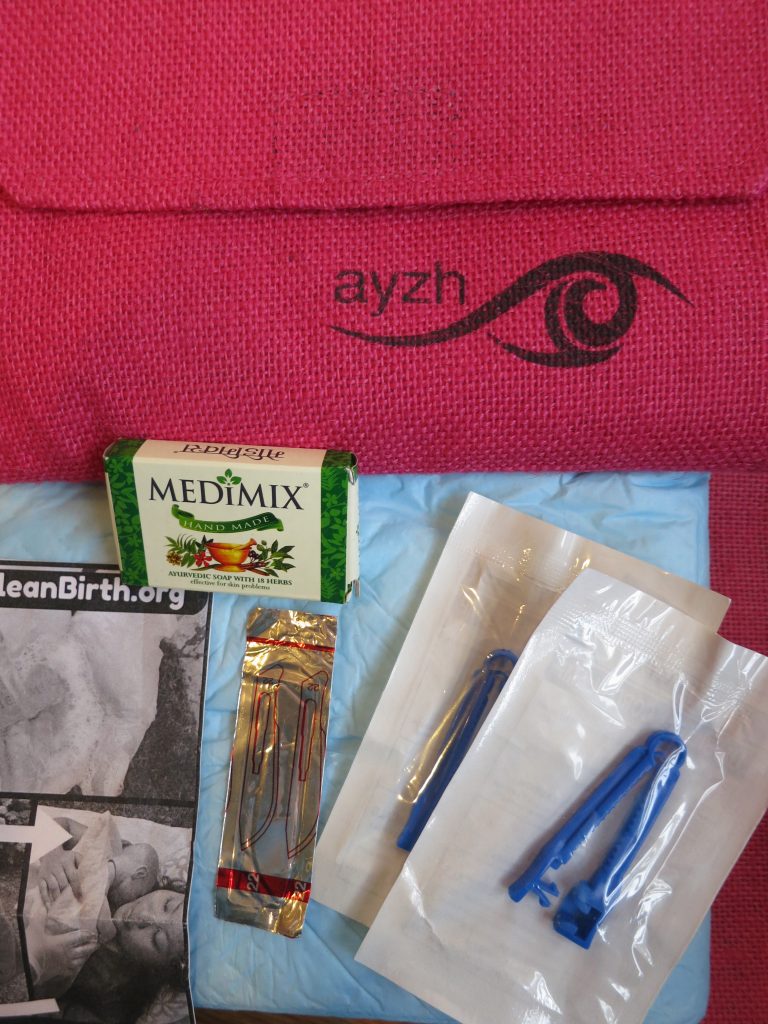
It’s true: the Clean Birth Kits my organization CleanBirth.org provides pregnant women in southern Laos do make birth safer when used correctly. Kits contain everything a mother needs to prevent infection in herself and her baby: gloves, soap, 2 clean absorbent pads, clean blade, 2 clean cord clamps, and picture instructions.
However, while the contents of this small pink bag can save lives, there is no guarantee they will.
In order to truly impact outcomes, the kits must be distributed by nurses who counsel mothers and families to use the supplies in a hygienic way, in the proper order, with a birth helper present.
The pivotal role of the local nurses is a lesson I have learned since we began supplying kits 3 years ago. Nurses speak the language, share the culture, and venture deep into jungle villages. They are the sole hope of villagers, who cannot travel to clinics due to distance, petrol expense, and washed out roads.
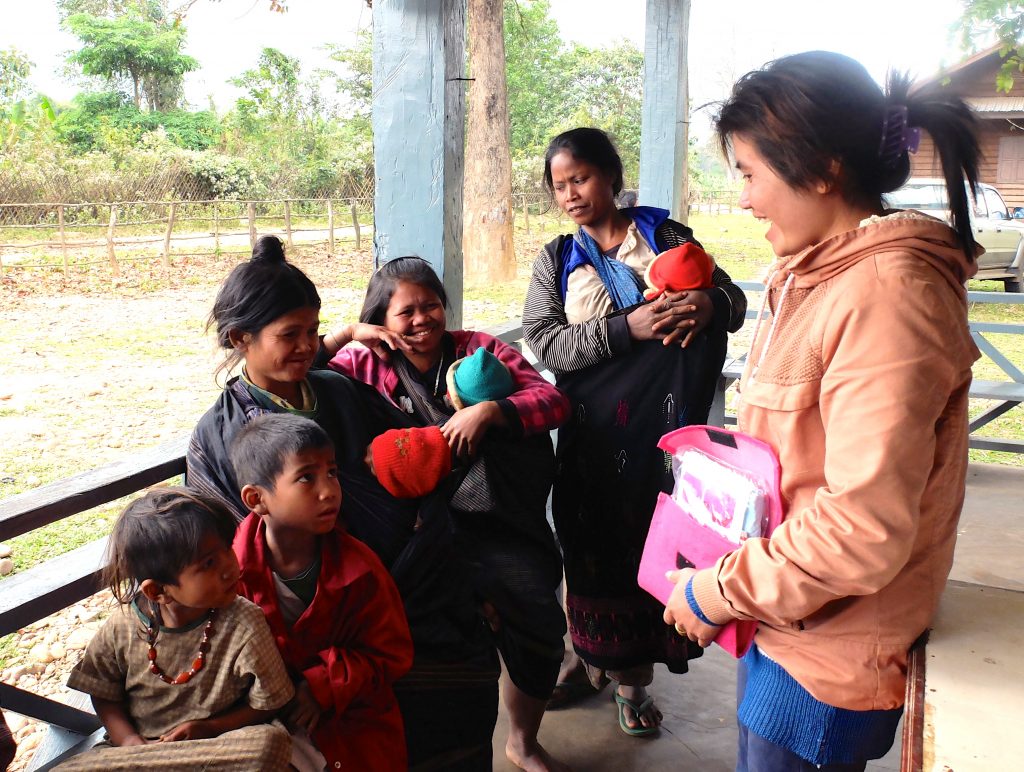
Well-trained nurses ensure that the promise of the small pink bags is realized in a healthy birth for baby and mother.
CleanBIrth.org works to give nurses the training they need by funding two trainings per year. This March, with our local partner and volunteer midwives from the Yale School of Nursing, we will again train nurses about Clean Birth Kits and the WHO’s Essentials of Newborn Care.
This year’s training will have a special focus on “Training the Trainer.” We want nurses to not only learn but to become teachers themselves.
To achieve our goal of training each and every one of the 62 nurses at the 31 clinics we serve, we need your help to raise $15,000 by February 13th.
You the readers and contributors of World Moms Blog have supported CleanBirth.org since it’s founding in 2012, and this year is no exception.
We are counting on you again. Please visit World Moms Blog’s fundraising page and donate what you can: $5 funds a birth kit, $120 provides Clean Birth Kits training for a nurse. http://cleanbirth.causevox.com/world-moms-blog
Thank you for your support!
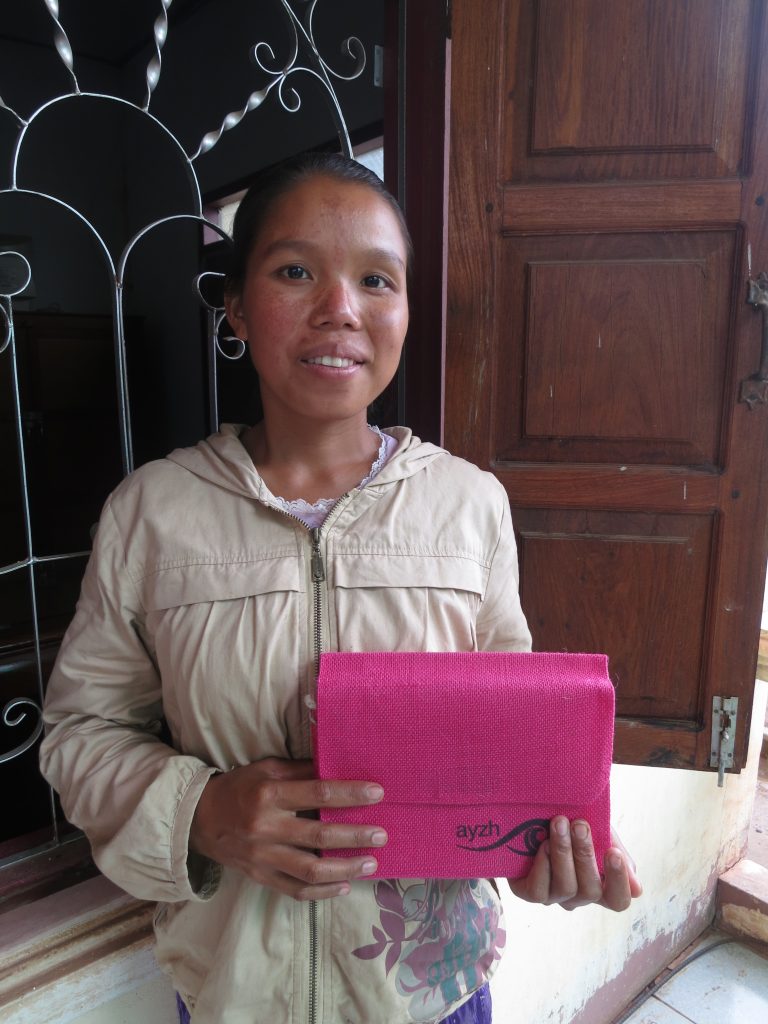
Since 2012, we have trained 200+ nurses and staff and provided 3,000 Clean Birth Kits to moms and babies in Laos. We pay nurses a stipend for the work that they do for CleanBirth.org.
This is an original post written for World Moms Blog by Kristyn Zalota, Founder CleanBirth.org
Photo Credits: Kristyn Zalota, Cleanbirth.org
Kristyn brings her years of experience as an entrepreneur and serial volunteer to CleanBirth.org. She holds a MA, has run small businesses in Russia and the US, and has volunteered in Nicaragua, Costa Rica, Thailand, Cambodia, Laos and Uganda on projects related to women’s empowerment.
After having children, Kristyn became an advocate for mothers in the US, as a doula and Lamaze educator, and abroad, as the Founder of CleanBirth.org. She is honored to provide nurses in Laos with the supplies, funding and training they need to lower maternal and infant mortality rates in their villages.
More Posts

by Elizabeth Atalay | Jan 19, 2016 | 2016, Africa, Humanitarian, International, United Nations, World Moms Blog, World Voice
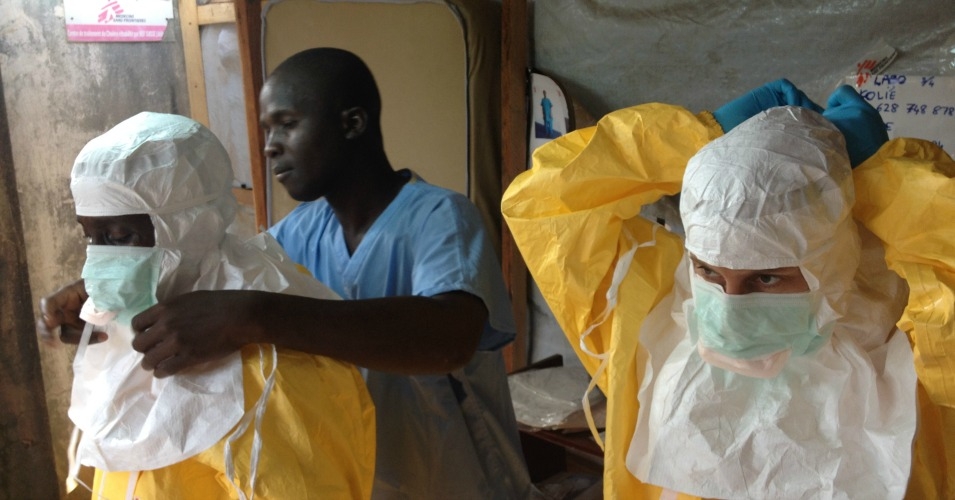
(Photo: European Commission DG ECHO/Flickr/Creative Commons)
The World Health Organization declared the Ebola outbreak in West Africa officially over this past week. The Ebola epidemic that swept through Guinea, Liberia, Sierra Leone, and into Nigeria last year highlighted the importance of rapid response, and strong health infrastructure. Credited for halting the spread of the virus more widely in Nigeria was the Polio tracking system and stations already put in place by GAVI (Global Vaccine Alliance). Unlike the surrounding countries, Nigeria was able to use that already existing health care network and alert system to quickly track down possible exposures. Also highlighted by the outbreak was the importance of nutrition in preventing disease to begin with. Well-nourished children have much stronger immune systems than malnourished children, and are more resilient to bounce back when they do get sick. Sustainable Development Goal number two is zero hunger, a global priority since WHO estimates that malnutrition is the underlying cause in half of child deaths world wide.
I knew that malnutrition made immune systems vulnerable, but working with a local non-profit specializing in the treatment and prevention of child malnutrition on a global level has given me new insight into just how critical proper nutrition is for the individual, and the world as a whole. You might be surprised to learn that the second largest producer in the world of a nutritionally fortified peanut paste used to treat malnutrition called Plumpy’Nut is located in the smallest state in the USA. Edesia is a non-profit that partners with organizations on the ground such as World Food Program, UNICEF and USAID to offer treatment and malnutrition prevention solutions to those who need it most. Countries such as Sierra Leone and Liberia had been receiving shipments of Edesia’s products long before the Ebola outbreak, where malnutrition was already an issue for many children before the virus hit. In the countries of Liberia, Guinea, and Sierra Leone the compounded crisis of child malnutrition was both a contributing factor, and then a cruel aftereffect of the Ebola epidemic.
Rhode Island infectious disease specialist Dr. Tim Flanigan, who traveled to Liberia in August of 2014 stated that
“More people were dying from malnutrition and other medical illnesses than from Ebola.” even at the height of the outbreak. “ So many infectious diseases are intertwined with malnutrition to begin with.”
The communities impacted the hardest were already fragile when the virus hit.
Dr. Flanigan explained, that the countries impacted by Ebola were some of the poorest countries on the continent. After years of civil wars, the destruction of the infrastructure had already made it a challenge for people to get enough to eat. Hunger, malnutrition, and starvation were already common realities in these vulnerable populations. All efforts and resources available then went to tackle Ebola when it hit, leaving any of the already challenged social services in place, like school meals or vaccine clinics, to flounder. When 20-day quarantines of people in homes with no running water, or electricity, (meaning no refrigeration for food), were instituted in some households, malnutrition rates were bound to soar.
Children are often the most vulnerable population in crisis scenarios, they are at much higher risk of disease when malnourished, even if they escape succumbing to any number of viral threats malnutrition puts them at risk of never growing to their full potential. The products produced in Rhode Island at Edesia, such as Plumpy’Nut and Plumpy’Sup, can literally save the lives of these children. In just 6 weeks on average a child suffering from Severe Acute Malnutrition, or SAM, can get back to their full healthy weight when treated with Plumpy’Nut. Last year Edesia reached nearly a million children. The United Nations Food and Agriculture Organization estimate is that nearly 795 million people (out of the 7.3 billion world population), so 1 in 9 people, suffered from malnutrition during 2014-2016. The goal at Edesia is to reach as many children as possible to help them thrive, and that means being prepared to react when the need arises. One of the essential building blocks to good health is proper nutrition, and a healthy community is a more resilient community. We saw how effective it was in the case of Nigeria and the Polio network to have systems in place when disaster strikes. The investment in global nutrition not only can help to prevent future outbreaks of disease, but ensure that all children have the opportunity to grow into healthy, productive adults.
What are some of the other lessons that this outbreak Highlighted?
This is an original post written for World Moms Blog by Elizabeth Atalay who also writes at documama and is the Digital and Social Media Specialist at Edesia.

Elizabeth Atalay is a Digital Media Producer, Managing Editor at World Moms Network, and a Social Media Manager. She was a 2015 United Nations Foundation Social Good Fellow, and traveled to Ethiopia as an International Reporting Project New Media Fellow to report on newborn health in 2014. On her personal blog, Documama.org, she uses digital media as a new medium for her background as a documentarian. After having worked on Feature Films and Television series for FOX, NBC, MGM, Columbia Pictures, Warner Brothers, 20th Century Fox, and Castle Rock Pictures, she studied documentary filmmaking and anthropology earning a Masters degree in Media Studies from The New School in New York. Since becoming a Digital Media Producer she has worked on social media campaigns for non-profits such as Save The Children, WaterAid, ONE.org, UNICEF, United Nations Foundation, Edesia, World Pulse, American Heart Association, and The Gates Foundation. Her writing has also been featured on ONE.org, Johnson & Johnson’s BabyCenter.com, EnoughProject.org, GaviAlliance.org, and Worldmomsnetwork.com. Elizabeth has traveled to 70 countries around the world, most recently to Haiti with Artisan Business Network to visit artisans in partnership with Macy’s Heart of Haiti line, which provides sustainable income to Haitian artisans. Elizabeth lives in New England with her husband and four children.
More Posts

by Eva Fannon (USA) | Jan 14, 2016 | 2016, Awareness, Cancer, Girls, Health, Kids, Maternal Health, North America, Older Children, Sex, USA, Vaccines, World Voice, Younger Children
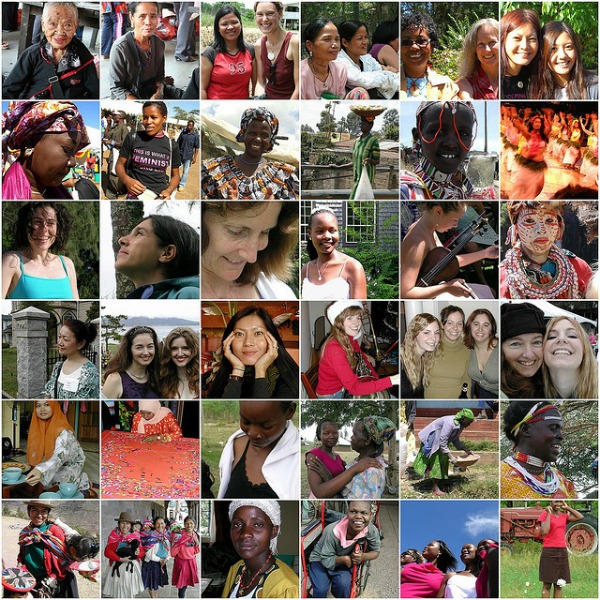
Many of us might hear the word “cancer” and automatically think that such a diagnosis would be a death sentence. This could be based on things we’ve heard, images we have seen portrayed in the media, or perhaps a personal experience – a friend or relative who has been affected by this “c” word. The truth is it greatly depends on the type of cancer…how early it is diagnosed…and whether or not a person has access to treatment.
In the US, January is #CervicalHealthMonth. Today we are talking it about it here because cervical cancer is an international issue and I’m sharing on World Moms Blog because it is an important topic to me, too. More than half a million women around the world are diagnosed with cervical cancer each year and over half of them die from the disease. The majority of these cases and deaths occur in low- and middle-income countries.(1) (more…)
Eva Fannon is a working mom who lives in the beautiful Pacific Northwest with her hubby and two girls. She was born and raised on the east coast and followed her husband out west when he got a job offer that he couldn't refuse. Eva has always been a planner, so it took her a while to accept that no matter how much you plan and prepare, being a mom means a new and different state of "normal".
Despite the craziness on most weekday mornings (getting a family of four out the door in time for work and school is no easy task!), she wouldn't trade being a mother for anything in the world. She and her husband are working on introducing the girls to the things they love - travel, the great outdoors, and enjoying time with family and friends. Eva can be found on Twitter @evafannon.
More Posts - Website
Follow Me:




by World Moms Blog | Jan 12, 2016 | 2016, Life Lesson, Middle East, Multicultural, Prejudice, Race, Refugees, Religion, Respect, World Moms Blog, World Voice
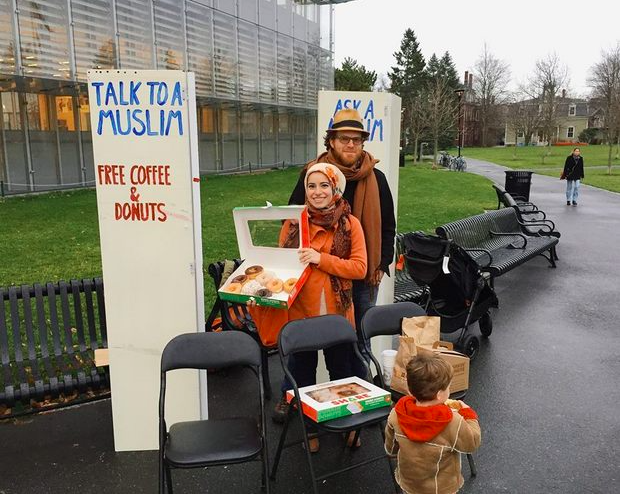
Photo: Courtesy of Mona Haydar
In the age of cellphones and social media, it’s very easy to disconnect from people without realizing you’re doing so. How many of us create walls subconsciously, especially if it concerns people of different nationalities we don’t usually associate with?
I was struck by a story of a woman who decided to set up a stand outside of a library in Cambridge, MA. Inspired by a story her husband saw on NPR titled “Ask an Iraqi”, Mona Haydar thought that it was important for her to establish a connection with those who may not know what’s it’s like to be a Muslim, especially a Muslim woman living in the United States.
For Haydar, setting up a stand titled “Talk To A Muslim” was a way for her to dispel any preconceived notions or stereotypes so many have of foreigners, especially of Muslim women.
With so many crises affecting different nationalities, in light of events happening in Syria, Haydar’s goal of creating a physical stand and waiting for people to approach her was a bold move since she had no clue how it would be received. What was surprising and hopeful was that people did stop by and spoke with Haydar, and that was a start. She was quite surprised to see how people did respond to her stand and while the reception was initially uncertain, it was enough for her to think about setting up the stand again.
In the current climate regarding people of cultures we aren’t familiar with, not willing to find out about them says more about us than them. There shouldn’t be a division of “them” and “us”, but unfortunately, there is.
How many times have we been guilty of giving in to fear of the unknown instead of taking a step back and dispelling the stereotypes we have learned about other cultures?
As someone who has had to answer questions about my nationality or religion over the years, the initial offense I felt has made me rethink of how people perceive me. Over the years, I have been mistakenly identified as either Korean or Japanese, rarely a Filipina. In addition, since I’m married to a Jewish man, I have been asked whether I’m a convert or adopted due to my Jewish maiden name, and to which I answer “no” to both. Answering these questions over the years, my frustration over being categorized primarily due to my physical appearance has made me realize that it’s not because of ignorance, but lack of communication. Asking questions and conversing about each other’s cultures would go a long way than being presumptuous about other people’s lives.
After reading about Haydar and seeing the NPR segment titled “Ask An Iraqi”, it made me wonder if we should put ourselves in Haydar’s shoes. Should we have to set up a stand in order to be understood or be compassionate towards others? Have we become so desensitized by our own prejudices that we have no room for being tolerant? I would hope not. Haydar’s stand may just be one form of starting conversations regarding one’s culture, but I think it’s an idea worth exploring. We might just realize that we may not look alike, but we all share the same intrinsic values of goodness towards humanity.
Read the original article regarding this post Here.
How do you think we can nurture better cross-cultural understanding?
This is an original post written by World Moms Blog Contributor Tes Silverman of The Pinay Perspective
World Moms Blog is an award winning website which writes from over 30 countries on the topics of motherhood, culture, human rights and social good. Over 70 international contributors share their stories from around the globe, bonded by the common thread of motherhood and wanting a better world for their children.
World Moms Blog was listed by Forbes Woman as one of the "Best 100 Websites for Women 2012 & 2013" and also called a "must read" by the NY Times Motherlode in 2013. Our Senior Editor in India, Purnima Ramakrishnan, was awarded the BlogHer International Activist Award in 2013.
More Posts

by Ms. V. (South Korea) | Jan 5, 2016 | 2016, International, UN, Uncategorized, Womanhood, Women's Rights, World Moms Blog, World Voice
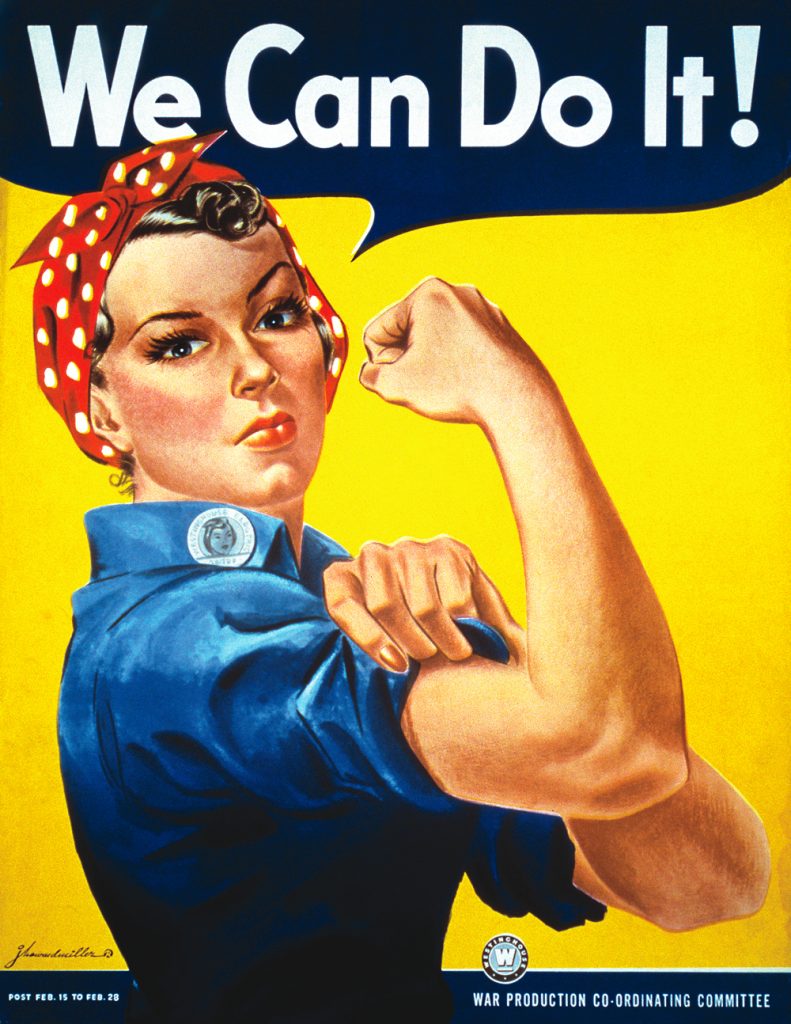 The UN recently sent a delegation of human rights experts to the US to report on this country’s overall treatment of women. The result? This is how the preliminary report concluded:
The UN recently sent a delegation of human rights experts to the US to report on this country’s overall treatment of women. The result? This is how the preliminary report concluded:
“The United States, which is a leading state in formulating international human rights standards, is allowing its women to lag behind international human rights standards. Although there is a wide diversity in state law and practice, which makes it impossible to give a comprehensive report, we could discern an overall picture of women’s missing rights. While all women are the victims of these missing rights, women who are poor, belong to Native American, Afro-American and Hispanic ethnic minorities, migrant women, LBTQ women, women with disabilities and older women are disparately vulnerable.”
The report touches on these “missing rights” in the realms of reproductive health, wages, politics, and violence- particularly gun violence- against women.
One of the delegates, Frances Raday, told reporters “The lack of accommodation in the workplace to women’s pregnancy, birth and post-natal needs is shocking. Unthinkable in any society, and certainly one of the richest societies in the world.”
As I read their conclusions, which will be further developed in a more comprehensive report in 2016, I felt a familiar sick feeling overcome my being. It’s the same sick feeling I’ve gotten used to since moving back to the US, every time there is yet another mass or accidental shooting. The two questions that come with this feeling are when and why? When will enough be enough? Why not yet?
As a woman and a mother – both to a male child and a female child – the urgency of full and true equality for women and girls is plain as day, not just for me and my daughter, but for the well-being of my son and all boys and men. Everyone is harmed by inequality, and I agree with Ms. Raday, that it is unthinkable in the context of this nation.
After I sit with when and why, I have to move to what. What can be done? What can I do, each and every day in my life, to make a difference? I’ll admit to feeling totally overwhelmed by that question at times, but I’ve found that it can all be boiled down to two things: stand up and speak out. Stand up for what is just and speak out about what needs to change. Or, as Susan B. Anthony said: Organize, agitate, educate.
At times I’ve let my fear of being perceived by others as a downer keep me from standing up and speaking out, but at this point in my life, the stakes are too high to be afraid. The stakes are too high for me and my family and for the millions of families who are affected by the situation of women in this country. So instead I choose to organize (build community) agitate (speak out) and educate (stand up).
I imagine my grandmother at the time of my birth thinking about what a different world I was being born into than the one she had known, and yet she never lived to witness true equality. The dream of full equality has been shared by several generations of women now. Do I dare hope that it will be achieved by the time my daughter comes of age? Will I meet my granddaughter and welcome her into a world where she has no “missing rights”?
Were you surprised to hear the findings of this delegation?
This is an original post written for World Moms Blog by Ms. V.
Image Credit: “We Can Do It!” by J. Howard Miller, artist employed by Westinghouse, poster used by the War Production Co-ordinating Committee – From scan of copy belonging to the National Museum of American History, Smithsonian Institution, retrieved from the website of the Virginia Historical Society.. Licensed under Public Domain via Commons
Ms. V returned from a 3-year stint in Seoul, South Korea and is now living in the US in the beautiful Pacific Northwest with her partner, their two kids, three ferocious felines, and a dog named Avon Barksdale. She grew up all over the US, mostly along the east coast, but lived in New York City longer than anywhere else, so considers NYC “home.” Her love of travel has taken her all over the world and to all but four of the 50 states.
Ms. V is contemplative and sacred activist, exploring the intersection of yoga, new monasticism, feminism and social change. She is the co-director and co-founder of Samdhana-Karana Yoga: A Healing Arts Center, a non-profit yoga studio and the spiritual director for Hab Community. While not marveling at her beautiful children, she enjoys reading, cooking, and has dreams of one day sleeping again.
More Posts
Follow Me:


by Purnima Ramakrishnan | Dec 14, 2015 | 2015, Asia, India, Natural Disaster, Nature, Purnima, The Alchemist, World Voice
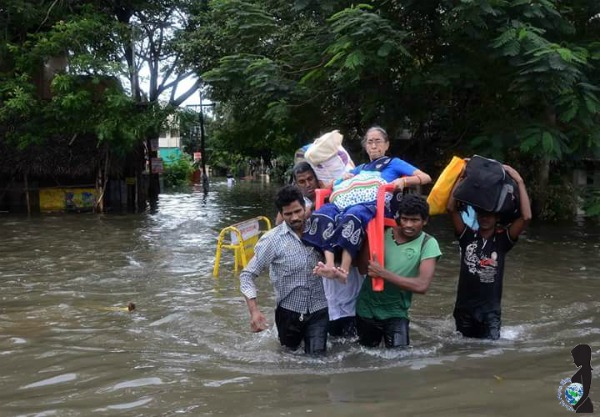
A woman being rescued from her house in Chennai, India.
My family lives in a low-lying area in Chennai, and we are, unfortunately, in the direct line of the reservoir’s outflow. We have been deeply affected by the #ChennaiFloods of 2015.
I’ve listened to to my son’s pleas to go back to his school which has been rained out for over a month. I have been heartbroken and in shock from the news of the many who have died around us from the floods. Helicopters overhead have dropped off supplies to my mother’s neighborhood. It began with a cyclone, and now the floods of Chennai, India have left the region where we live, in a crisis.
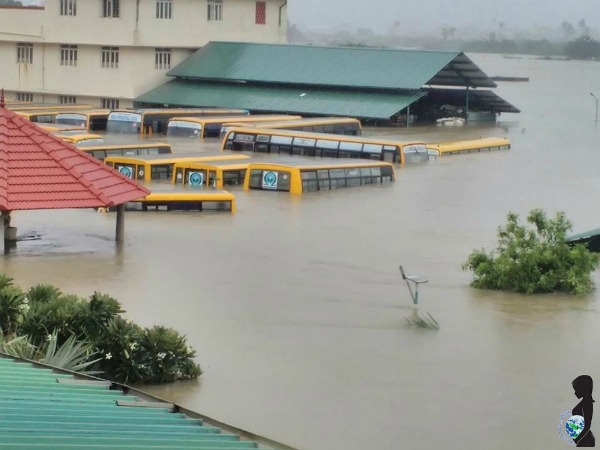
The school of the photographer’s daughter and buses under water in Chennai due to extreme flooding.
It was a wrong call. The people keep on saying this over and over again. In the newspapers. In social media. Chennai has had the highest rains in 100 years, but that is not what has caused our city’s problems. Lapses and error in human judgement, unplanned and predatory city development, high rise buildings on dried up river and lake beds, clogged drain water pipes, and a very poor civic administration are what led to our current catastrophe.
And the reservoirs and dams were opened up at the wrong time. This was a disgrace!
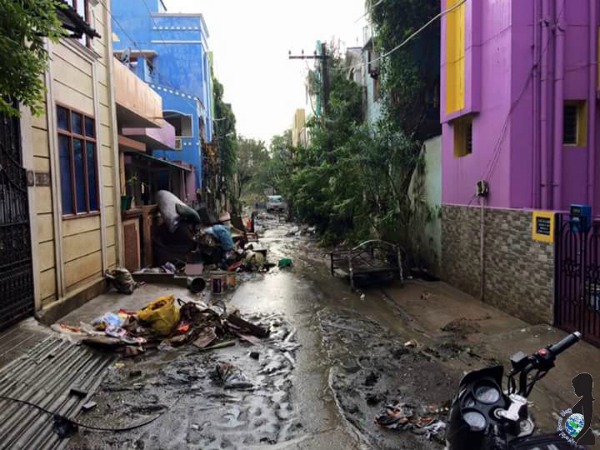
Sedimentary debris left behind by flood waters in Chennai, India.
The government had adequate warning from the weather department, but failed to respond in time. Who is responsible for this? One person’s bad judgment or that of one state government department led to this event which has been called a national disaster and crisis. Over 500 are dead, as bodies are still being recovered from receding waters, with over 1.8 million people losing their homes and possessions, and a net worth loss of $3 billion to the Indian Economy.
My city, fondly called Singara Chennai (Beautiful Chennai) in my native Tamil language, has now been aptly called Sink-aagara Chennai (Sinking Chennai) all over Social Media.
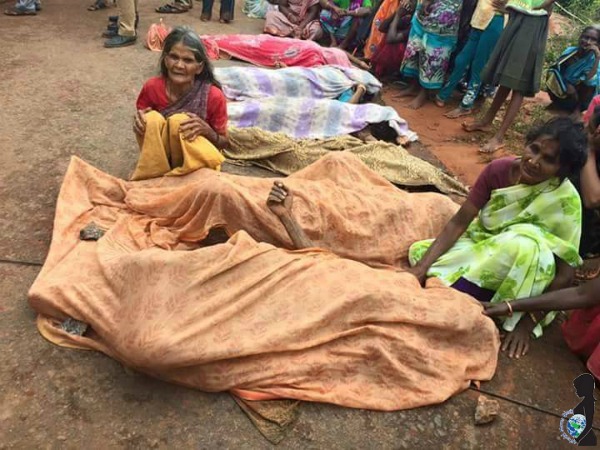
Dead bodies are covered as women mourn. Over 500 people have lost their lives in the Chennai Flood.
The damage is colossal. I am still numb reading and listening to accounts of dead bodies emerging from receding waters and closed highways because of the river in spate. Then there was the opening of Chennai International Airport after a long closure, the naval war ships coming to rescue people from the Chennai seaport, reported deaths in hospitals because of power outages, and the dead piling up and decomposing. Pregnant women were being airlifted from high rise apartments.
During all this, there was just this crazy thought in our hearts as parents, that our son should survive this.
It is our hope that our son survives all this mess, the bureaucracy, and live in a beautiful, safe world.
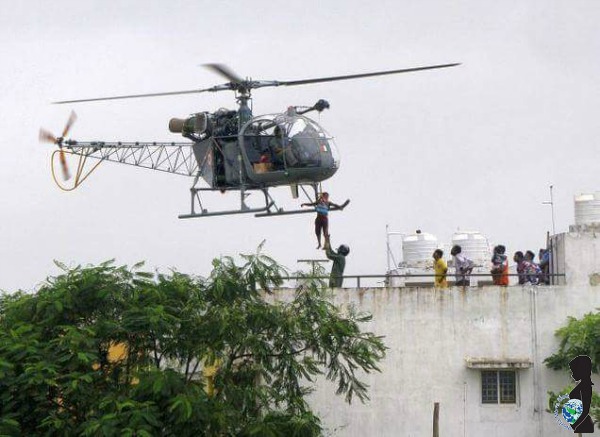
A helicopter evacuates a person who needs medical care in Chennai, India.
On the night of the reservoir opening up, we went over to our neighbour’s place in the first floor (in India the first floor is above the ground floor), because of the fear of flood waters entering our homes on the ground floor. It was with great pain that we left our home (for a single night), which we had built with all of our love and life savings, at a time when we had nowhere else to go. It was far too emotional.
I thought, it’s not the floods, not the waters, not being left homeless or penniless, but it is this great fear in our hearts of the questions. “What life are we leaving for our son? How are we leaving the earth, for all generations to come? What is happening with humanity right here, before our eyes? How did we, as a community, allow this to happen?”
Yes, the deluge of rain was unforeseen, an act of nature – but Chennai was left unprepared for it.
Left unprepared, because of the subconscious feelings and acts of violence, hatred, prejudice, jealousy, in the hearts of men. Left unprepared, because of the bending of rules and flouting of norms in the name of development of urban land. Left unprepared, because of the nonchalance on the part of governmental officials in the event a flood warning is issued. Left unprepared, because of the switching off of phones of the city police officers for emergency call-ins. I could go on.
We have watched apocalyptic movies like “2012″ and “Independence Day.” And, this week, we found ourselves living it.
As we waded through the flood waters to our neighbour’s place on the first floor, my son jokingly said, “Is this how it was like, for Noah, during the great biblical flooding?” We all humored him and laughed with a pain in our hearts.
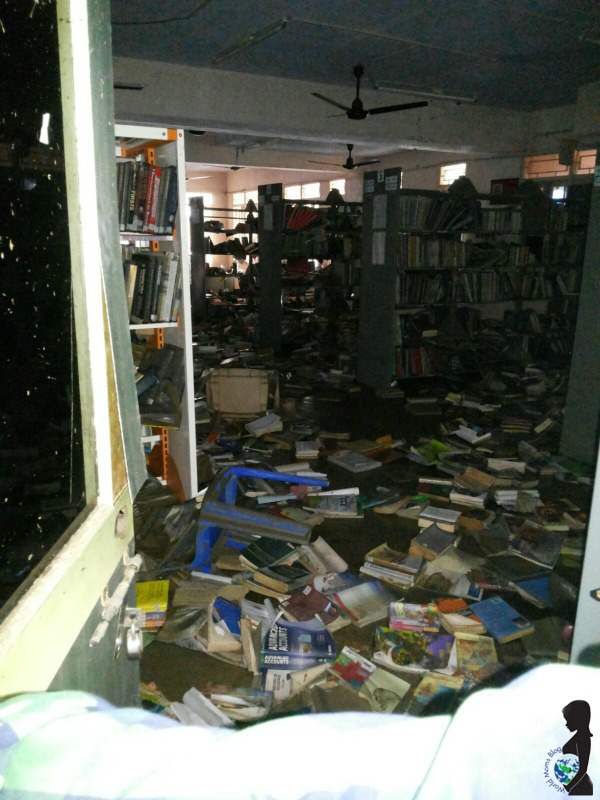
A school library in Chennai that was wrecked by the flooding.
I keep my head up and continue with the strenth of these words from a speech given by my spiritual friend, Shri Parthasarathi Rajagopalachri. It is almost a year since he passed on, but his legacy and love, lives on in Heartfulness Meditation, which he has left behind.
“We have a duty to our race (human beings); We have a duty to the world. We are not just nationalistic, which is very narrow. We are responsible for the universe. One problem in Japan – the tsunami, a problem with their atomic [power] generator and the whole world is shivering. Which wind will blow what towards us? A flu somewhere, and everybody is sick; at all airports there are tests. Today, it is not your country or my country – it is my world. Anything happening anywhere can affect us. Bomb blasts in Mumbai. “Oh, But I am in Chennai.” Where next?
It all stems from the violence in the individual mind of every one of us here. We have violent thoughts. We have thoughts of acquisition, of greed, of power. Our politicians lead the country in this mad race towards destruction. We follow. They want votes based on religion, we are willing. “Who will vote for me?” So in the newspapers you find suddenly the Muslims are pampered, they are given special facilities – for the Muslim vote. In another area, it is the Christian vote. Nobody talks of the genuine vote, the legal vote, the moral vote – and we are prey to all of them.”
…
“The Veda (ancient sanskrit scriptures) says, let only noble thoughts come to me from everywhere in the universe (aa no bhadraah kratavo yantu vishvatah).”
…
“Always look at the heart whenever you are afraid, whenever you are going off track. Babuji Maharaj always said, “Don’t trust this head. It is only a thinking thing. It will give you information. It cannot tell you what is right or wrong. When you are in doubt, refer to the heart.”
The heart never misleads. The heart always tells you the right thing to do. It is way beyond morals, ethics and judgements. It always tells you how to go about peace, love and joy. The heart is the way. We could have done better. We MUST do better.
As a parent, as a mother, as a human being, I want to leave behind a just world where serenity and tranquility prevails.
This is an original post from our UNCA Award Winning World Mom and Senior Editor in India, Purnima Ramakrishnan.
Her contributions to World Moms Blog can be found here.
Photo credits to Savitha, Purnima’s sister-in-law.







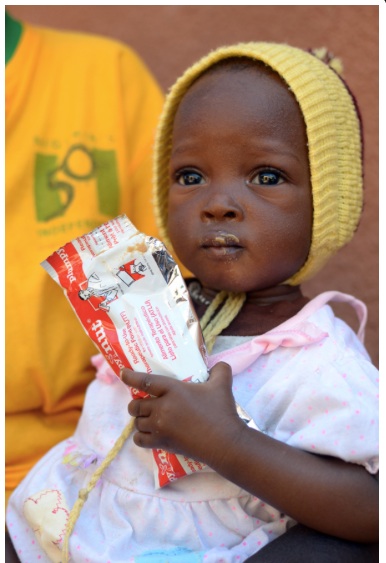








 The UN recently sent a delegation of human rights experts to the US to report on this country’s overall treatment of women. The result? This is how the preliminary report concluded:
The UN recently sent a delegation of human rights experts to the US to report on this country’s overall treatment of women. The result? This is how the preliminary report concluded:











